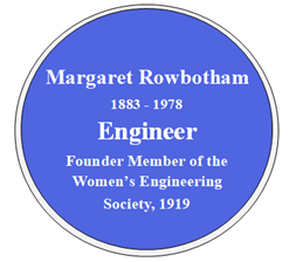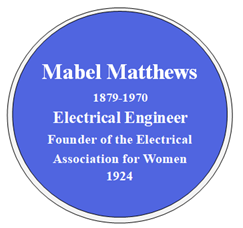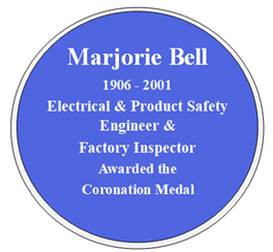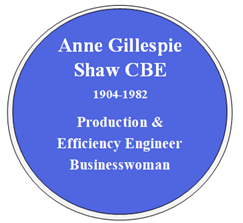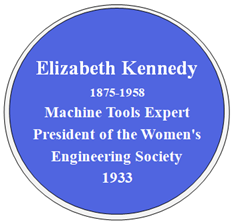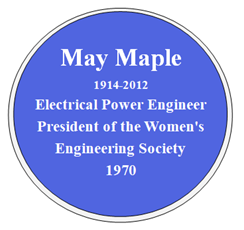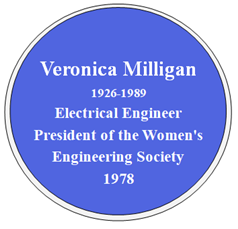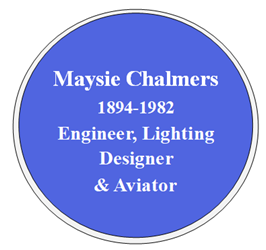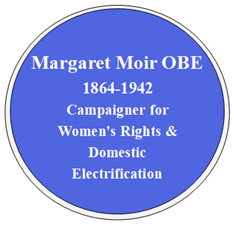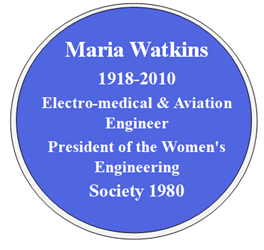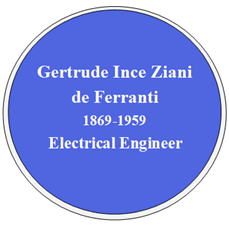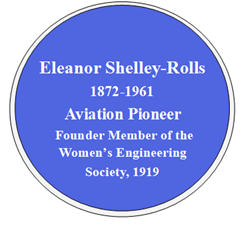Virtual Blue Plaques for Women Engineers
On International Women's Day, March 2024, we launch a series of virtual blue plaques to commemorate the lives of some of the incredible women behind the Women's Engineering Society and the Electrical Association for Women. We hope that some of these will turn into actual blue plaques during this centenary year of the formation of the Electrical Association for Women. If you are from any of the areas identified and would like to pursue the establishment of a blue plaque (or fund it) then please get in touch.
|
Jeanie Dicks
1893-1980 Electrical engineer who led the electric lighting of Winchester Cathedral in 1934. Jeanie took over her father’s gas and electricity business after his death in 1926, and went on to manage the company’s electrical contracting business as well as its gas and water projects. Jeanie joined the Women’s Engineering Society in 1924 and the Electrical Contractors Association in 1929. She took a keen interest in radio technology and registered the amateur radio callsign 6JN. On her death in 1980, the Hampshire Chronicle described her as ‘one of the city’s leading businesswomen’. Place of blue plaque: Winchester |
|
Margaret Rowbotham
1883-1978 Electrical and mechanical engineer who was a founder member of the Women’s Engineering Society. Margaret studied mathematics at Girton College and spent some time teaching at Roedean. She was a keen amateur motorcyclist (in 1939 she was described as one of the first six women motorcyclists) and trained as an automobile engineer with the British School of Motoring. Margaret worked as a works supervisor at Galloway Engineering in the First World War, later moving to the Swainson Pump Company in Newcastle. In 1927, she was appointed a director of the engineering firm M Partridge and Co and moved to Devon to live with her partner and the company founder, Margaret Partridge. Margaret died in 1978. Place of blue plaque: Woolwich |
|
Mabel Matthews
1878-1970 Electrical and production engineer who proposed the foundation of the Electrical Association for Women. Mabel began work as a secretary after the death of her husband in 1909. She worked for a paper maker and by 1923 was in charge of the electrical department of the Consolidated Pneumatic Tool Company, She joined the Institution of Electrical Engineers as a Graduate then Associate Member and was a member of the Women’s Engineering Society. In 1924, Mabel proposed the formation of a women’s electrical association to encourage women to use electricity to make their lives easier. The new organisation was a success, and Mabel served as Vice-President. She retired in 1940. Place of blue plaque: Wakefield, Yorkshire |
|
Marjorie Bell
1906-2001 Chartered electrical engineer and factory inspector who was the first woman to study engineering at Northampton Institute. Marjorie began working as a factory inspector in 1936 and received a medal for her work in the Second World War. Marjorie was a prominent figure in electrical safety and worked on the first EU committee for electrotechnical standardisation, focusing on the safety of electrical toys. She was the first woman to chair a British Standards Institution technical committee. Marjorie served as President of the Women’s Engineering Society in 1956 and was a member of the member of the Institution of Electrical Engineers, the Institution of Industrial Safety Officers and the Institution of Occupational Safety and Health. Marjorie died in 2001. Place of blue plaque: Edmonton, Middlesex |
|
Gertrude Entwistle
1892-1961 Electrical engineer who was the first woman engineer to work at British Westinghouse and the first woman to be elected as a student member of the Institution of Electrical Engineers. Gertrude studied physics at the University of Manchester and attended engineering classes when they were first opened to women in 1912. After leaving university in 1915, Gertrude joined British Westinghouse (later Metropolitan Vickers) as an engineer, specialising in AC and DC motors. Shew was able to continue working at the company after the end of the First World War and retired in 1954. Gertrude was a founder member of the Women’s Engineering Society as served as President from 1941-1943. Place of blue plaque: Swinton, Greater Manchester |
|
Anne Gillespie Shaw CBE
1904-1982 Anne Gillespie Shaw was an engineer and businesswoman who pioneered the use of time and motion studies in the UK. She studied at the University of Edinburgh and Bryn Mawr College, Pennsylvania, where she met Dr Lilian Gilbreth. Anne became Lilian’s research assistant before returning the UK in 1930 to work for Metropolitan Vickers. Anne was a member of the Women’s Engineering Society and produced a film for the Electrical Association for Women on applying time and motion studied to food preparation. She founded the company Anne Shaw Organisation and wrote and lectured extensively on time and motion theory. Anne was an Honorary Fellow of the Institution of Production Engineers and was awarded a CBE in 1954. Place of blue plaque: Uddingston, Scotland |
|
Elizabeth Kennedy
1875-1958 Engineer and businesswoman who became the managing director of the machinery manufacturer J B Stone. Elizabeth began her career as a typist in the company, and was appointed as Company Secretary in 1915, becoming Managing Director shortly afterwards. Elizabeth joined the Women’s Engineering Society in 1935 and was appointed President in 1932. Place of blue plaque: Camberwell |
|
May Maple
1914-2012 Electrical engineer who was the first woman to work as a Contracts engineer for the Central Electricity Generating Board (CEGB). May began her career at the London Transport Board in 1939, moving to Edmundson’s Electricity Corporation, where she studied for an HNC in electrical engineering. Post nationalisation, she worked for the Central Electricity Board in their contracts department and became a Contracts Officer in 1965. May joined the Institution of Electrical Engineers in 1955 and was elected a Fellow in 1969. May was President of the Women’s Engineering Society in 1970 and was awarded the Isabel Hardwich medal in 1991. Place of blue plaque: Gateshead |
|
Veronica Milligan
1926-1989 Electrical engineer and first woman engineer to work for the South West Electricity Board. Veronica originally studied English and Economics but decided to take an HNC in electrical engineering while raising her young family. She began as a graduate trainee at SWEB, supervising the repair of an 11kV line after the previous engineer electrocuted himself. In 1961, she set up the consultancy company CivLec Industrial Advisory Services with her husband. Veronica would go on to advise government on industrial management and worked with the Commission on Energy and Manpower and the Council of Engineering Institutions. She was appointed President of the Women’s Engineering Society in 1978. Place of blue plaque: Pontypridd, South Wales |
|
Maysie Chalmers
1894-1982 Electrical engineer and aviator who was the first art advisor on electric lighting in the UK. Maysie began her career as an actress, but took a correspondence course on engineering in the First World War. She became a specialist in decorative electric lighting and had a showroom on the Brompton Road in London. In 1937, the engineering firm British Thomson-Houston appointed her as its first lighting art advisor. Maysie also trained as a pilot and maintenance engineer and in 1932 flew to Baghdad, Babylon and Ur with her first husband, John Pender Chalmers. She was an active member of the Electrical Association for Women, serving as Vice President, and wrote on aeronautics for the Women’s Engineering Society. Place of blue plaque: Hawarden, Flintshire |
|
Margaret Moir OBE
1864-1942 Engineer and campaigner for workers’ rights who was a founder member of the Women’s Engineering Society. Margaret, Lady Moir was President of the Women’s Engineering Society in 1929 and President of the Electrical Association for Women in 1931.Margaret travelled with her husband, the engineer Ernest Moir, and helped with his projects, once describing herself as an ‘engineer by marriage’. She worked as a lathe operator in the First World War and campaigned for better conditions for women working in munitions. She was awarded an OBE in 1920. Margaret also supported the training of women engineers and hosted talks by the pioneering aviators Amy Johnson and Mary, Lady Bailey at her London home. Place of blue plaque: Edinburgh |
|
Maria Watkins
1918-2010 Defence electronics engineer who became President of the Women’s Engineering Society in 1980. Maria was born in Vienna and grew up in Lvov, Poland. She came to Edinburgh to study electrical engineering in 1938, becoming the first woman to take the course. After the outbreak of the Second World War, Maria stayed in the UK but her family were not able to join her and her parents and grandparents died in the concentration camps. Maria began her career as a technical assistant at Johnson and Philips and became an assistant to Jules Thorn, the founder of Thorn Electrical Industries. She worked on guidance systems and the PLUTO pipeline and volunteered as an air raid warden, In 1947, Maria was appointed a lecturer at South East London Technical College, later working at City University. She was a Liveryman and senior steward of the Worshipful Company of Scientific Instrument Makers, a Freeman of the City of London, a Life Fellow of the Royal Society of Arts and a Fellow of the Institution of Electrical Engineers. Place of blue plaque: Blackheath & Edinburgh |
|
Gertrude Ince Ziani de Ferranti
1869-1959 Campaigner on women in engineering and supporter of the Electrical Association for Women, serving the association in various national and local office-bearing roles. Gertrude was the wife of the engineer Sebastian de Ferranti and helped recruit women to work for the Ferranti engineering company. Their various all-electric homes were frequently visited by EAW groups. She was a member of the Royal Institution. In 1936, she and the engineer Caroline Haslett were the only two women to travel as representatives to the World Power Conference. Place of blue plaque: Roath, Glamorgan |
|
Eleanor Shelley-Rolls
1872-1961 Founder member of the Women’s Engineering Society and early aeronaut. Eleanor Shelley-Rolls flew in hot air balloons and early Zeppelins before the First World War and was interested in aviation and transport engineering. In 1919, Eleanor was one of seven women to found the Women’s Engineering Society, and in 1921 co-founded the engineering company Atalanta Ltd with Katherine, Lady Parsons. Atalanta was a mechanical engineering company that only employed women, including the engineer Annette Ashberry. Eleanor was the Women's Engineering Society representative for the Electrical Association for Women, a member of the Council Industrial Co-partnership and President of Women's Pioneer Housing. Place of blue plaque: Monmouth |
|
Laura Annie Willson
1877-1942 Trades union activist, engineer, suffragette and housebuilder, she was also a Founder of the Women's Engineering Society. Laura Annie Willson was a Yorkshirewoman to her boots and lived and worked in Halifax most of her life. With toolmaker husband George Henry Willson they established Smith, Barker and Willson,a successful engineering works in Halifax and she would become one of its directors. She was a member of the Women’s Labour League and the Women’s Social and Political Union, and was one of the first women to receive an MBE, in 1917, for her war work. In 1925 became the first woman member of the Federation of House Builders. She built several low cost housing estates in the Halifax area, and later in Surrey. Place of blue plaque: Halifax |

